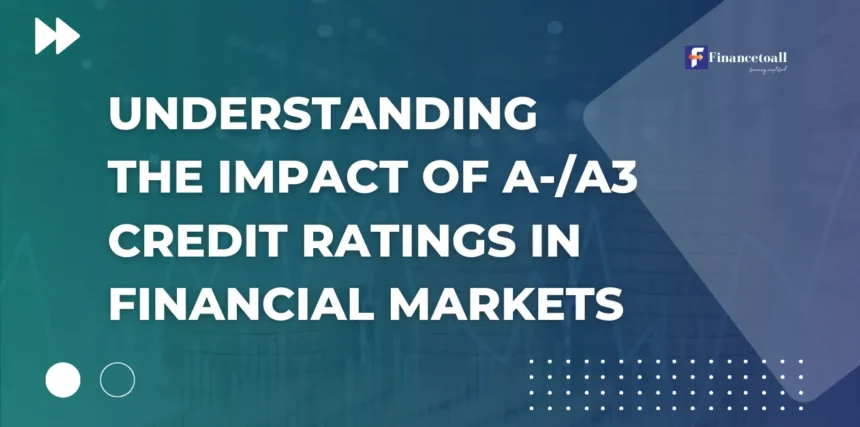Introduction to Credit Ratings
A- and A3 Credit ratings are indispensable tools in the financial sector, crucial for assessing the creditworthiness of issuers such as corporations, governments, and municipal entities. These ratings, determined by well-known agencies like Standard & Poor’s, Moody’s, and Fitch, provide investors, companies, and governments with a metric to gauge credit risk, which in turn influences interest rates and investment decisions.
Understanding A- and A3 Ratings
- Rating Scale: A- and A3 ratings fall within the upper-medium investment-grade category. These ratings suggest relatively low credit risk, making them attractive to a broad array of investors.
- Comparison of Agencies: It’s important to recognize that A- is assigned by Standard & Poor’s and Fitch, while Moody’s uses A3. Each agency has its unique scale and methodology, though their assessments are broadly similar at this level.
- Characteristics: Entities with A-/A3 ratings typically have a robust capacity to meet their financial commitments. However, they are more susceptible to changes in economic conditions compared to those with higher ratings, such as AA- or Aa2.
Implications for Borrowers
- Borrowing Costs: Generally, entities with A- or A3 ratings enjoy lower borrowing costs due to the perceived lower risk, which translates into more favorable interest rates from lenders.
- Market Perception: These ratings enhance the market perception of a company or government entity, bolstering investor confidence and potentially easing the capital-raising process through debt or equity markets.
You Can Also Read About: A+/A1 Credit Ratings
Impact on Investors
- Risk vs. Return: The balance of risk and return for A-/A3-rated securities is favorable, offering stability and reasonable yields, which are particularly appealing to conservative investors.
- Portfolio Considerations: For portfolio managers, incorporating A-/A3-rated securities helps in achieving a diversified investment portfolio that is resilient during market volatility and provides steady returns.
Case Studies and Historical Context
- Real-World Examples: Companies in stable industries like utilities or consumer staples often maintain A-/A3 ratings due to their consistent revenue streams and strong financial health.
- Historical Performance: During financial downturns, such as the 2008 financial crisis, A-/A3-rated entities typically exhibit better resilience compared to those with lower ratings, though they may not perform as well as higher-rated entities.
Factors Influencing Ratings
- Economic Environment: Global and national economic conditions like GDP growth, inflation, and interest rates significantly affect these ratings.
- Company-Specific Factors: Financial metrics such as profitability, leverage, and cash flow are closely scrutinized by rating agencies when assigning or revising ratings.
Rating Outlooks and Changes
- Outlooks: These provide guidance on potential rating changes due to expected economic or operational shifts within the rated entities.
- Downgrades and Upgrades: Fluctuations in financial health or economic conditions can lead to rating changes, which directly impact investor sentiment and market behavior.
Criticism and Controversies
Despite their critical role, rating agencies often face criticism regarding their methodologies and the potential conflicts of interest, especially highlighted during financial crises. These criticisms suggest a need for investors to possibly utilize additional tools and analyses beyond traditional ratings to assess credit risk comprehensively.
Conclusion
Understanding A-/A3 ratings is crucial for financial stakeholders, impacting decisions from corporate finance strategies to individual investment choices. As economic landscapes evolve, the role and interpretation of these ratings also change, making it imperative for market participants to stay informed and adapt their strategies accordingly. This article provides a foundational understanding and encourages deeper exploration into the nuanced implications of credit ratings in modern financial markets.
FAQ on A- and A3 Credit Ratings:
Q.1 What does an A-/A3 rating signify about a company’s financial health?
It indicates that the company has a strong capacity to meet its financial obligations, though it’s somewhat more susceptible to adverse economic conditions than higher-rated companies.
Q.2 How do A-/A3 ratings affect a company’s borrowing costs?
Companies with these ratings generally face lower borrowing costs compared to lower-rated companies, reflecting their lower risk of default.
Q.3 Why might an investor choose an A-/A3 rated bond or security?
Such securities offer a balance of safety and yield, making them attractive for conservative investors who prefer minimal risk but expect reasonable returns.
Q.4 Can A-/A3 ratings change? If so, what might cause this?
Yes, ratings can be upgraded if a company’s financial situation improves significantly or downgraded in case of worsening financial health or adverse macroeconomic conditions.
Q.5 What are the criticisms faced by rating agencies?
Agencies are often criticized for their potential conflicts of interest and the significant impact their ratings can have during financial crises, questioning the accuracy and impartiality of their ratings.








